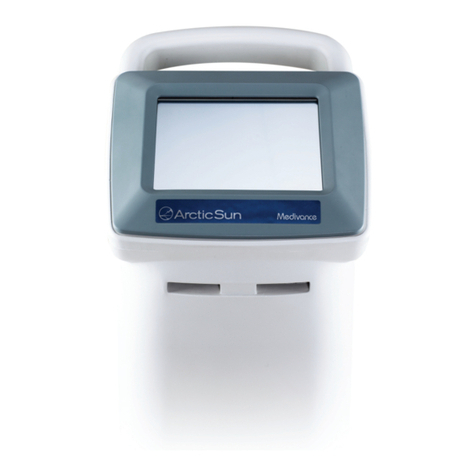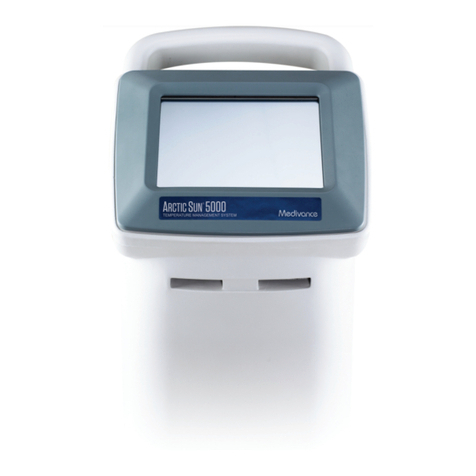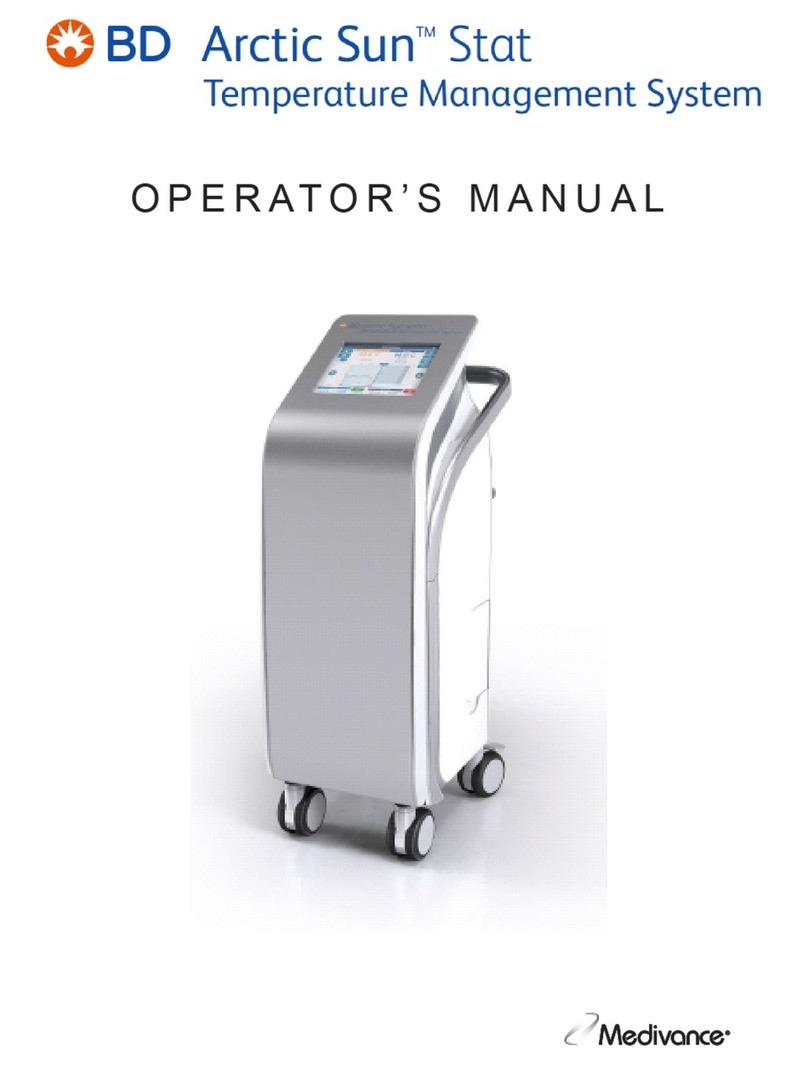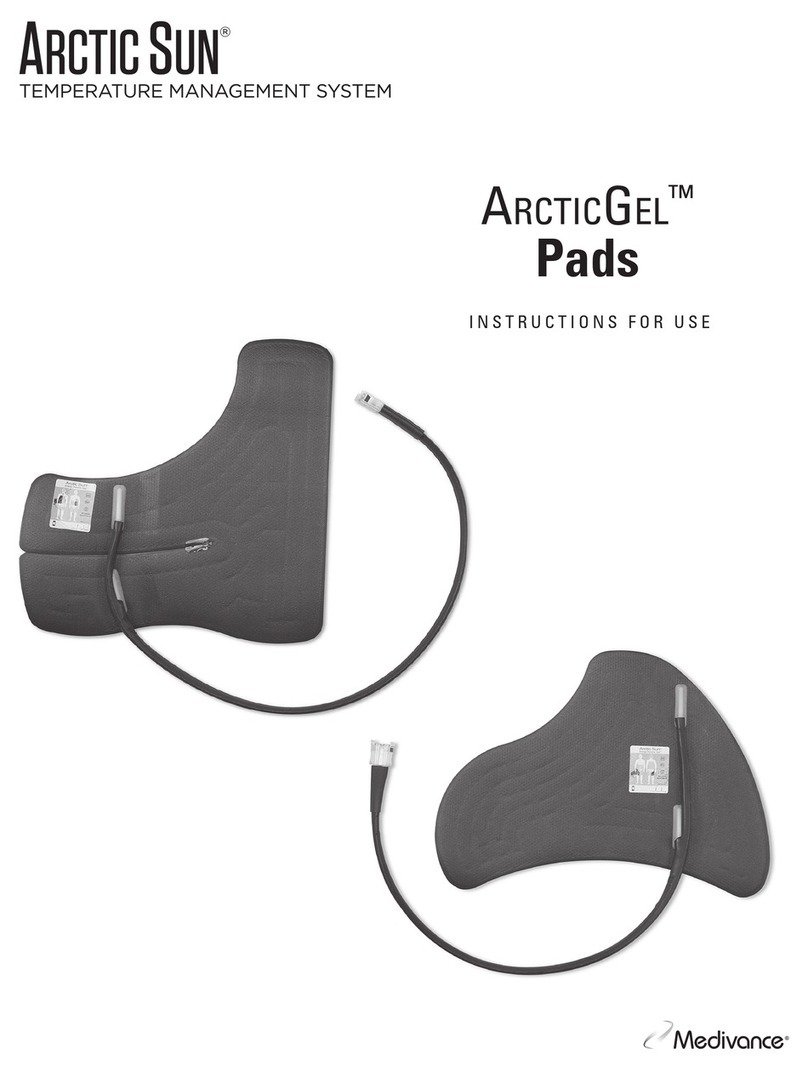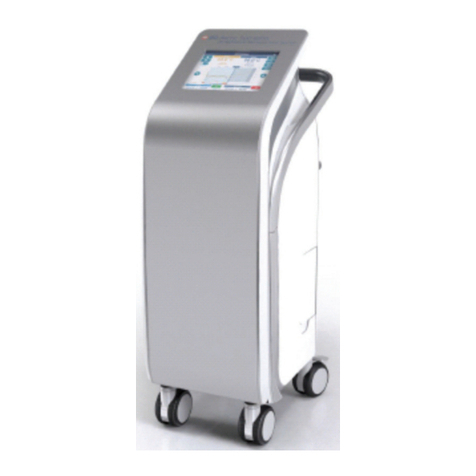
1
Chapter 1 – Getting Started
Indications for Use
The ARCTIC SUN®Temperature Management System is intended for
monitoring and controlling patient temperature.
Warnings and Cautions
Warnings
• Do not use the ARCTIC SUN®Temperature Management System in the
presence of flammable agents because an explosion and/or fire may result.
• Do not use high frequency surgical instruments or endocardial catheters
while the ARCTIC SUN®Temperature Management System is in use.
• There is a risk of electrical shock and hazardous moving parts. There are
no user serviceable parts inside. Do not remove covers. Refer servicing to
qualified personnel.
• Power cord has a hospital grade plug. Grounding reliability can only be
achieved when connected to an equivalent receptacle marked “hospital
use” or “hospital grade”.
• When using the ARCTIC SUN®Temperature Management System, note that all
other thermal conductive systems, such as water blankets and water gels, in
use while warming or cooling with the ARCTIC SUN®Temperature Management
System may actually alter or interfere with patient temperature control.
• Do not place ARCTICGEL™Pads over transdermal medication patches as
warming can increase drug delivery, resulting in possible harm to the patient.
Cautions
• This product is to be used by or under the supervision of trained, qualified
medical personnel.
• Federal law (USA) restricts this device to sale, by or on the order of a
physician.
• Use only distilled or sterile water. The use of other fluids will damage the
ARCTIC SUN®Temperature Management System system.
• When moving the ARCTIC SUN® Temperature Management System always
use the handle to lift the controller over an obstacle to avoid over balancing.
• The patient’s bed surface should be located between 30 and 60 inches (75
cm and 150 cm) above the floor to ensure proper flow and minimize risk of
leaks.
• The clinician is responsible to determine the appropriateness of custom
parameters. When the system is powered off, all changes to parameters
will revert to the default unless the new settings have been saved as
new defaults in the Advanced Setup screen. For small patients (≤30 kg)
it is recommended to use the following settings: Water Temperature
High Limit ≤40°C (104°F); Water Temperature Low Limit ≥10°C (64.4 °F);
Control Strategy =2.
• The operator must continuously monitor patient temperature when using
Manual Control and adjust the temperature of the water flowing through the
pads accordingly. Patient temperature will not be controlled by the ARCTIC
SUN®Temperature Management System in Manual Control.
• Due to the system’s high efficiency, Manual Control is not recommended
for long duration use. The operator is advised to use the automatic therapy
modes (e.g. Control Patient, Cool Patient, Rewarm Patient) for automatic
patient temperature monitoring and control.
• The
ARCTIC SUN®Temperature Management System will monitor and control
patient core temperature based on the temperature probe attached to the
system. The clinician is responsible for correctly placing the temperature
probe and verifying the accuracy and placement of the patient probe at the
start of the procedure.
• Medivance recommends measuring patient temperature from a second site
to verify patient temperature. Medivance recommends the use of a second
patient temperature probe connected to the ARCTIC SUN®Temperature
Management System Temperature 2 input as it provides continuous
monitoring and safety alarm features. Alternatively, patient temperature
may be verified periodically with independent instrumentation.
• The displayed temperature graph is for general information purposes only
and is not intended to replace standard medical record documentation for
use in therapy decisions.
• Patient temperature will not be controlled and alarms are not enabled in
Stop Mode. Patient temperature may increase or decrease with the ARCTIC
SUN®Temperature Management System in Stop Mode.
• Carefully observe the system for air leaks before and during use. If the pads
fail to prime or a significant continuous air leak is observed in the pad return
line, check connections. If needed, replace the leaking pad. Leakage may
result in lower flow rates and potentially decrease the performance of the
system.
• The
ARCTIC SUN®Temperature Management System is for use only with the
ARCTICGEL™Pads.
• The ARCTICGEL™Pads are only for use with the ARCTIC SUN®Temperature
Management Systems.
• The ARCTICGEL™Pads are non-sterile for single patient use. Do not reprocess
or sterilize. If used in a sterile environment, pads should be placed
according to the physician’s request, either prior to the sterile preparation
or sterile draping. ARCTICGEL™Pads should not be placed on a sterile field.
• Use pads immediately after opening. Do not store pads once the kit has
been opened.
• Do not place ARCTICGEL™Pads on skin that has signs of ulceration, burns,
hives, or rash.
• While there are no known allergies to hydrogel materials, caution should
be exercised with any patient who has a history of skin allergies or
sensitivities.
• Do not allow circulating water to contaminate the sterile field when patient
lines are disconnected.
• The water content of the hydrogel affects the pad’s adhesion to the skin
and conductivity, and therefore, the efficiency of controlling patient
temperature. Periodically check that pads remain moist and adherent.
Replace pads when the hydrogel no longer uniformly adheres to the skin.
Replacing pads at least every 5 days is recommended.
• Do not puncture the ARCTICGEL™Pads with sharp objects. Punctures will
result in air entering the fluid pathway and may reduce performance.
• If accessible, examine the patient’s skin under the ARCTICGEL™Pads often,
especially those at higher risk of skin injury. Skin injury may occur as a
cumulative result of pressure, time and temperature. Do not place bean bag
or other firm positioning devices under the ARCTICGEL™Pads. Do not place
positioning devices under the pad manifolds or patient lines.
• The rate of temperature change and potentially the final achievable
patient temperature is affected by many factors. Treatment
application, monitoring and results are the responsibility of the
attending physician. If the patient does not reach target temperature
in a reasonable time or the patient is not able to be maintained at the
target temperature, the skin may be exposed to low or high water
temperatures for an extended period of time which may increase
the risk for skin injury. Ensure that pad sizing / coverage and custom
parameter settings are correct for the patient and treatment goals,
water flow is greater than or equal to 2.3 liters per minute and the
patient temperature probe is in the correct place. For patient cooling,
ensure environmental factors such as excessively hot rooms, heat
lamps, and heated nebulizers are eliminated and patient shivering
is controlled. Otherwise, consider increasing minimum water
temperature, modifying target temperature to an attainable setting or
discontinuing treatment. For patient warming, consider decreasing
maximum water temperature, modifying target temperature to an
attainable setting or discontinuing treatment.
• Due to underlying medical or physiological conditions, some patients are
more susceptible to skin damage from pressure and heat or cold. Patients
at risk include those with poor tissue perfusion or poor skin integrity due to
diabetes, peripheral vascular disease, poor nutritional status, steroid use
or high dose vasopressor therapy. If warranted, use pressure relieving or
pressure reducing devices under the patient to protect from skin injury.
• Do not allow urine, antibacterial solutions or other agents to pool
underneath the ARCTICGEL™Pads. Urine and antibacterial agents can absorb
into the pad hydrogel and cause chemical injury and loss of pad adhesion.
Replace pads immediately if these fluids come into contact with the
hydrogel.
• Do not place ARCTICGEL™Pads over an electrosurgical grounding pad. The
combination of heat sources may result in skin burns.
• If needed, place defibrillation pads between the ARCTICGEL™pads and the
patient’s skin.
• Carefully remove ARCTICGEL™Pads from the patient’s skin at the completion of use.
Discard used ARCTICGEL™Pads in accordance with hospital procedures for medical
waste.
ENGLISH
The current Operator’s Manual can be found at www.medivance.com/manuals.















